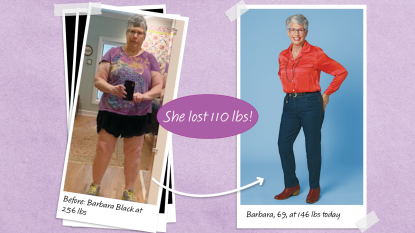Your Guide to Ozempic and the New Weight-Loss Drugs: Top Experts + Real Women Tell All
Kimberlie Rush, 60, lost 102 lbs — learn about her journey and what helped along the way
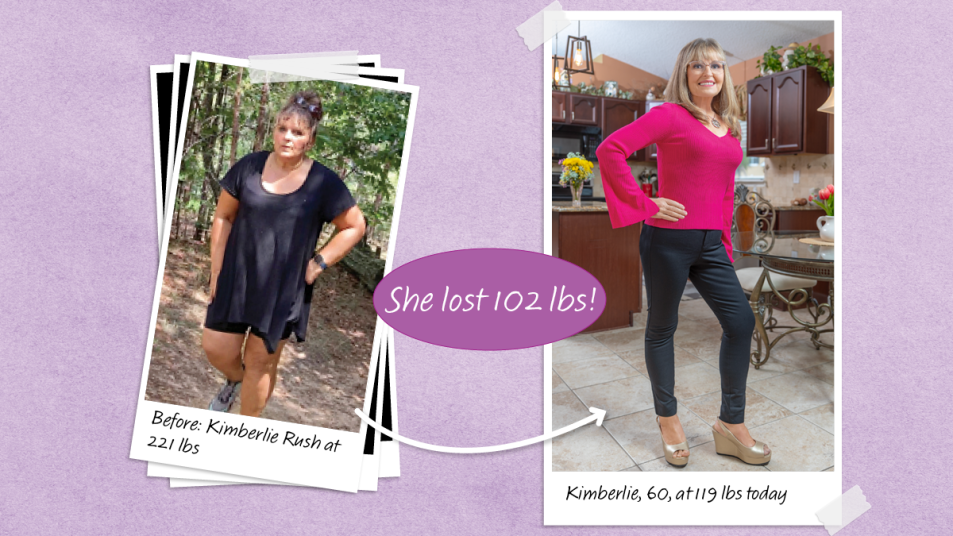
Everyone is buzzing about Ozempic, Mounjaro and other new injectable meds that just might be the answer to our weight-loss prayers. Yet most of us have no clue how they work, if they’re safe and if insurance pays. For answers, we turned to Weill Cornell Medicine obesity expert Louis Aronne, MD, whose research on the drugs recently appeared in the prestigious Journal of the American Medical Association. We also tapped Kimberlie Rush, 60, and Crystle Constiner, 51, women who say the new meds have allowed them to lose significant weight, lower sky-high blood sugar, relieve arthritis pain, ditch their blood-pressure meds and more. Keep reading for your guide to Ozempic and other new weight-loss drugs.
Guide to Ozempic, Mounjaro + more: What these drugs do
First things first: The fancy name for the medications we’re talking about is GLP-1 agonists, a category that includes brand names Ozempic, Trulicity, Wegovy, Mounjaro and Zepbound. Most come in pens and are injected weekly. They were developed as diabetes meds; Wegovy and Zepbound are versions created and approved specifically for weight loss. Dr. Aronne says all versions work by mimicking GLP-1, a hormone our body makes to help control blood sugar and turn off hunger.
Turns out, modern diets (with all their ultra-processed foods and huge portions) can “overload certain nerves, making the brain resistant to weight-regulating hormones including GLP-1,” explains Dr. Aronne. It’s part of the reason we sometimes want to stuff our faces even when we’ve just eaten. Taking synthetic GLP-1 — which doesn’t break down as quickly or easily inside our bodies as the real thing — will, at least in theory, “help create the feeling that you just ate dinner, so you don’t want more food,” says the doc. The drugs have side effects and aren’t right for everyone, “but weight loss is unprecedented with these medicines.”
Related: Ozempic for Women Over 50? 5 Doctors Weigh In on the New Weight-Loss Injectables
Answers to your questions on the new weight-loss drugs
If you’re curious about GLP-1 meds, here’s what you probably want to know:
How much weight do people lose on Ozempic and other drugs?
A number of older studies show losses of about 10% of a person’s body weight. But newer meds used in combination with lifestyle changes push the stat higher. “There was a Zepbound trial that led to a 22.5% loss of body weight and one on Mounjaro where they got a 26% loss,” notes Dr. Aronne. And that’s just on average. Some folks will quit the meds due to side effects and barely lose; others will use the drugs as a tool to stick to smart choices and ultimately hit an optimal weight.
The latter was the case for Kimberlie Rush. “I have struggled with weight my whole life, losing and then gaining — but mostly gaining,” shares the Florida grandmother, down 102 pounds. “After using Mounjaro, I’m smaller than I was in the 5th grade.”
Do you lose weight right away?
“Weight loss usually begins gradually and picks up steam,” says Dr. Aronne. “These medications are generally one shot per week, and the amount of medication in each shot will gradually increase.” Your doctor will help you find the highest level you tolerate well.
Crystle Constiner was initially put on Trulicity for diabetes. “I lost 10 pounds in two months, mostly because I was too nauseated to eat,” shares the Ohio grandmother, 51. Once she switched to Mounjaro, the nausea subsided. “I lost 14 pounds the first month.” Crystle now says she only experiences it if she eats a very large or rich meal; she lost a total of 84 pounds in nine months.
What’s the biggest change people experience on weight-loss drugs?
It’s not just that appetite decreases but rather that “food noise” — the obsessive, intrusive thoughts about what and when to eat next — dies down or goes away. “I’m what they refer to as a ‘super responder.’ I felt immediate change,” says Kimberlie, who for years constantly thought about her next meal even if she was already eating. “The food noise was gone on day one. I also went from being a sugar addict to having no desire for sweets. Even bread tasted too sweet at times.”
Crystle notes that her tastes also changed. “Not in a bad way, though. I’m drawn more toward steak and chicken,” she says. “I don’t want snacks, but I do sometimes want candy. I’ll have four to five peanut M&M’s and be content. It did eliminate my desire for alcohol. I’ve heard it helps people get rid of the desire to smoke too.”
Related: “I Lost 224 Lbs — More Than Half My Size! — With This Keto Hack That Cured My Cravings”
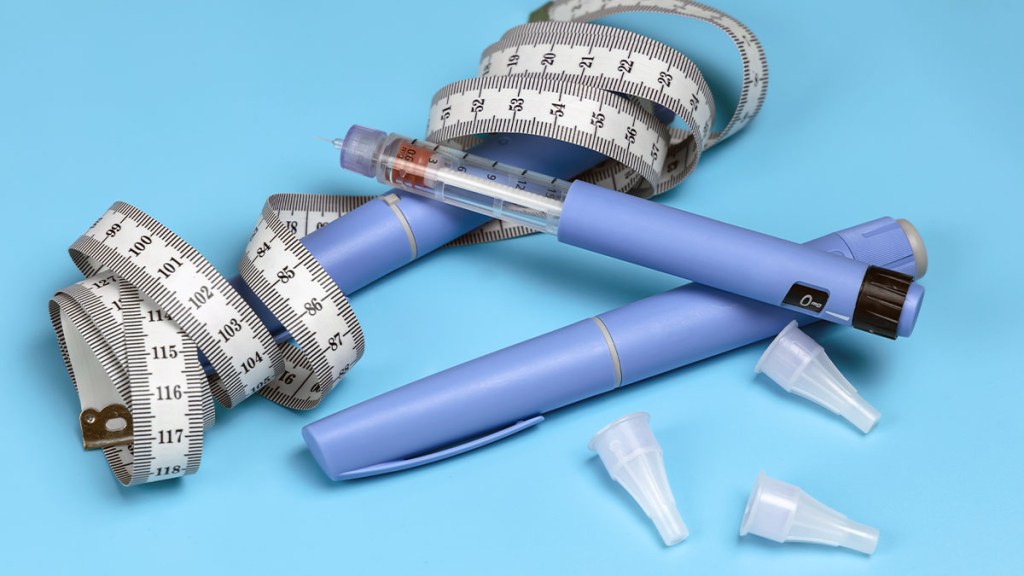
Do the injections hurt?
“They’re self-injecting pens, and you just hold them against your belly or thigh and push a button,” says Crystle. “The needles are tiny and don’t go in deep. I don’t even feel them.” Kimberlie agrees: “It’s not at all painful.”
What about side effects from the new weight-loss drugs?
GI upset is main issue, says Dr. Aronne. About half of patients experience nausea; it’s also fairly common to deal with vomiting, diarrhea and/or constipation. “Initially, if you limit fatty foods, it helps minimize side effects,” shares Dr. Aronne. “And for the vast majority of people, symptoms subside as we adjust the dose.”
For Crystle, changing meds helped. “Trulicity gave me diarrhea and nausea, which I hated,” she says. “The first two injections of Mounjaro I was really, really tired. But now I only have nausea if I eat a heavy meal — and it’s nothing too bad.”
Dr. Aronne adds that most other side effects, like headaches and fatigue, are less common and less bothersome. But serious reactions are rare but possible. Always read warnings that come with a new prescription. (Click through to learn more about how Ozempic makes you tired.)
Related: MD: You Can Get the Weight Loss Benefits of Ozempic *Without* the Side Effects
Any surprise risks?
“I think the biggest risk comes from ordering these drugs online and not getting proper supervision,” says Dr. Aronne. Drugs ordered online can be counterfeit and dangerous, and even if you get the real thing, they’re easy to misuse. “I’ve heard of people ending up in the ER with severe abdominal pain. The drugs are a powerful treatment for obesity, which is a disease that has been hard to treat before this. But you absolutely need proper medical guidance.”
Who should and shouldn’t take these meds?
“They can be considered for anyone with chronic obesity or anyone who has medical issues tied to weight, such as high blood sugar or high blood pressure,” says Dr. Aronne. The main exceptions: The drugs aren’t recommended for anyone with chronic GI trouble or pancreatitis, he says.
What’s the difference between all the GLP-1 meds?
Dosing, potency and FDA approval can vary. Rybelsus, for example, is an oral (not injected) medication that is the same as Ozempic, stimulates some weight loss and is only approved as a treatment for type-2 diabetes.
If slimming down is your goal, here’s what you need to know: The generic name of Ozempic and Wegovy is semaglutide; it works on our cells in just one way. Tirzepatide, the generic name for Mounjaro and Zepbound, works on cells in two different ways and has proven up to three times more effective for weight loss.
Related: TikTok Influencers Call It ‘Nature’s Ozempic’: Can Berberine Really Help You Lose Weight?
Will I lose muscle?
Rapid weight loss typically causes loss of muscle, and this does happen with GLP-1 meds. “A study on Wegovy found that 33% of weight lost was muscle and lean mass,” says Dr. Aronne. Promising research is underway to prevent the effect. And, in the meantime, Dr. Aronne thinks the evidence suggests benefits of GLP-1 meds outweigh the downside for many patients with weight-related health risks. For example, new studies show GLP-1 meds block diabetes 73% of the time. “We can now prevent most people from getting the disease,” he says. “We also have proof that people with heart disease who lose weight with these medications are less likely to have a heart attack or stroke.”
Dr. Aronne adds that eating a higher-protein diet and doing resistance training can offset muscle loss while taking GLP-1 meds.
Related: What You Should Be Eating to Fight Muscle Loss as You Age
What gets better besides weight?
“If you lose 15% or more of your body weight, you typically see significant improvements in blood sugar, blood pressure, acid reflux, arthritis, fatty liver, sleep apnea and heart health,” says Dr. Aronne.
When will insurance pay?
Medicaid, Medicare and many insurance plans don’t cover any medication strictly for weight loss. But a recent survey found two of every five employers intend to begin covering GLP-1 meds in 2024. And if you have type 2 diabetes like Crystle did, you may have better luck. “My insurance paid,” she shares. “And my blood sugar and A1C are now normal!”
How much does it cost out-of-pocket?
Zepbound was approved in late 2023 and released at a price point of $1,035 a week — about $350 less than Wegovy. Competition between brands should slowly drive costs down. For now, manufacturer discount cards can lower the price tag to about $550 a month and sometimes even less.
Do you end up heavier if you stop the meds?
Viral social media posts make it seem like you do — but those posts are very misleading. In Dr. Aronne’s recent Zepbound study, test subjects were secretly switched to a placebo after 32 weeks and, on average, regained 14% of their weight in a year. Another study on 20,274 Wegovy patients who stopped the drug found that 17.7% did regain all lost weight or end up heavier than they started — but over 80% regained very little or continued losing.
Still worried you’d regain? Dr. Aronne says one option is to take the medication at least intermittently. Or, if you’re like Crystle, you can stay on them for good, much as you would with cholesterol medication.
As for Kimberlie, she says she’s proof you can stop the meds and stay lean. “I had a savings card from Mounjaro, but once it expired, I could no longer afford the meds,” she says. “I’m hoping to go back on it someday, but I’m keeping up with my lifestyle changes, like walking with a weighted vest three to four days a week. I’ve maintained my loss for six months.” She says she would do it all again in a heartbeat. “These meds aren’t an easy way out. There is hard work involved. And I recently needed surgery to remove excess skin. But I feel so good now. I definitely have no regrets!”
Mounjaro before and after: Kimberlie Rush, 60
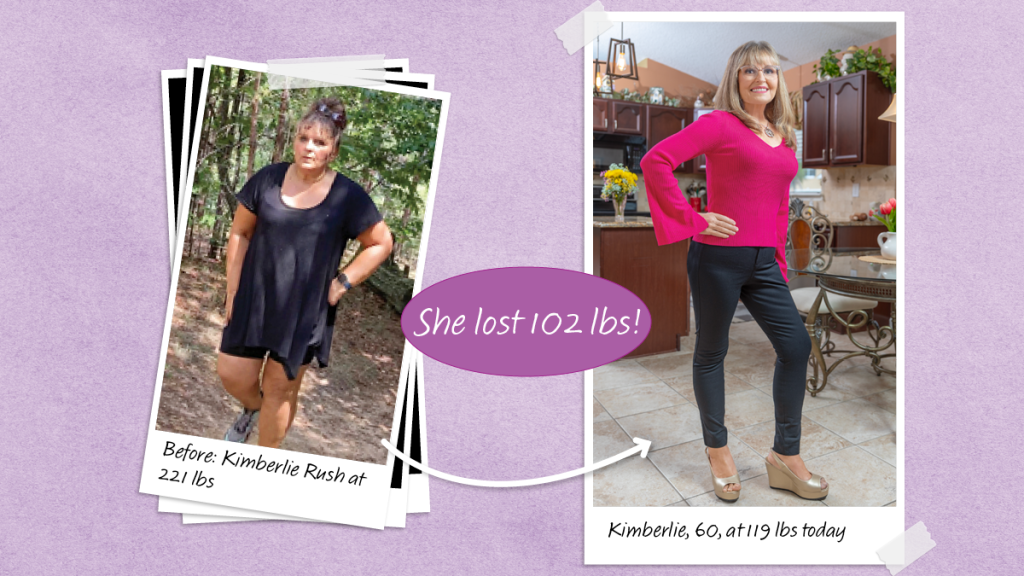
In 2022, “My mom was sick and I needed to get in better shape to care for her,” recalls. Kimberlie Rush, 60. Constant urges to eat had left the Florida teacher’s aide so heavy, she struggled to get around. “I also had high blood sugar, high blood pressure, migraines, plantar fasciitis and was always tired.” Though nervous, she called a weight-control specialist. “When he found out I exercised regularly, he thought it was a sign I’d switch to a healthier lifestyle and do well on Mounjaro. At the time, I was his first patient using the drug.”
She got her first dose. “That day, the nonstop thoughts of food I’d had my whole life were gone,” she recalls. “It was odd but wonderful.”
Kimberlie initially had mild nausea; it soon passed. Down about 4 pounds a week at first, “I focused on protein and avoided things I used to overeat. The meds made it easy.” Over time, she experimented. “I found I could have a few bites of anything, enjoy it and be done.”
In a year, she shed 102 pounds. Her blood work perfect, she even got off antidepressants. “I didn’t want to stop Mounjaro, but I had no choice because of the cost. There were some white-knuckle moments.” But her appetite is far quieter than it used to be. And she has more energy to stay active, key to maintenance. “I feel great about the future!”
Mounjaro success story: Crystle Constiner, 51
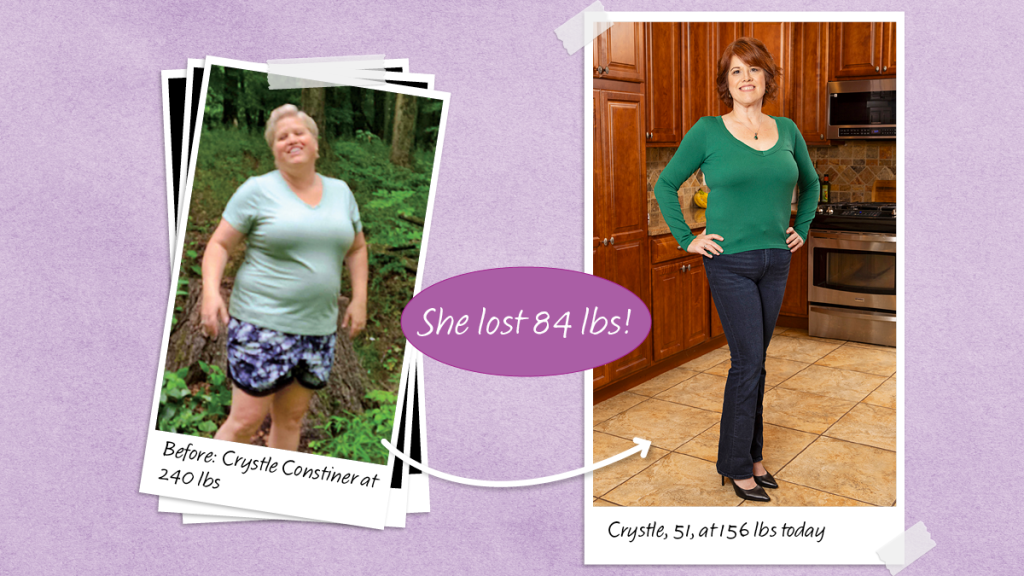
As a busy mom of four, Crystle Constiner ate whatever was cheap and comforting. “My weight kept going up, and I developed arthritis, high blood pressure, type 2 diabetes and a heart condition,” shares the Ohio office coordinator, 51. “I was miserable.” She tried every diet she could find — WeightWatchers, South Beach, keto and countless more. “But I was hungry all the time. Within 30 minutes of a meal, my brain wanted more. I thought surgery was my only hope, so I was saving up.”
Then she heard about GLP-1 meds. “I had taken metformin for years. My doctor agreed to switch me to Trulicity. Between October and December, I lost 10 pounds but had low-level nausea all the time.” So Crystle asked about Mounjaro and was allowed to try it.
Her ongoing nausea lifted and her appetite shrank. “I stopped thinking about food after the second shot,” she remembers. “From that point on, I was able to make better choices. I mostly have protein and veggies, but if I want something, I’ll have it. I just don’t eat much anymore. I’ll get fries and have three.”
Her energy up, she does strength training or goes for a walk most days. Maintaining an 84 pound loss for four months, her joints feel great and her mood is high. “I got off three blood pressure meds, but my doctor anticipates I’ll be on Mounjaro forever. It keeps me healthy, so I’m okay with that. I feel like this medicine has been an absolute miracle for me.”
Click through for more ways to kill hunger and cravings as you lose weight.
Weight Loss Success: “I Lost 217 lbs Using This Everyday Snack to Turn Off Cravings”
Drop Pounds and Conquer Cravings With This 28-Day Detox
Top Doc Reveals the Salt Trick That Makes It Easier to Lose Weight During the Holidays













